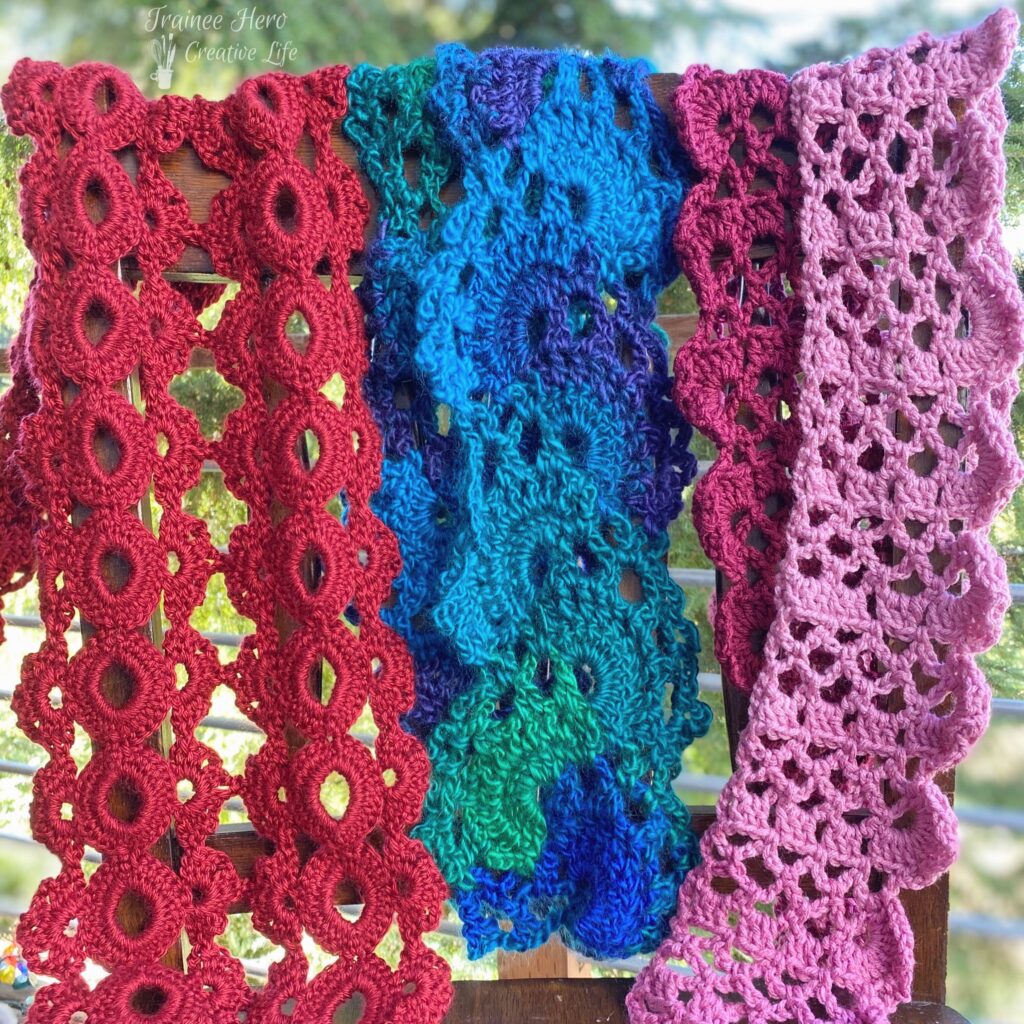
I’m excited to present the third installment in my series on off-label uses for crochet edging patterns! This post focuses on crochet edging pattern scarves. If you didn’t catch my posts on bracelets and headbands, you’ve got to check them out! It turns out edging patterns are perfect for making accessories. Today, I share my experience making three scarves from edging patterns and tips for making your own.
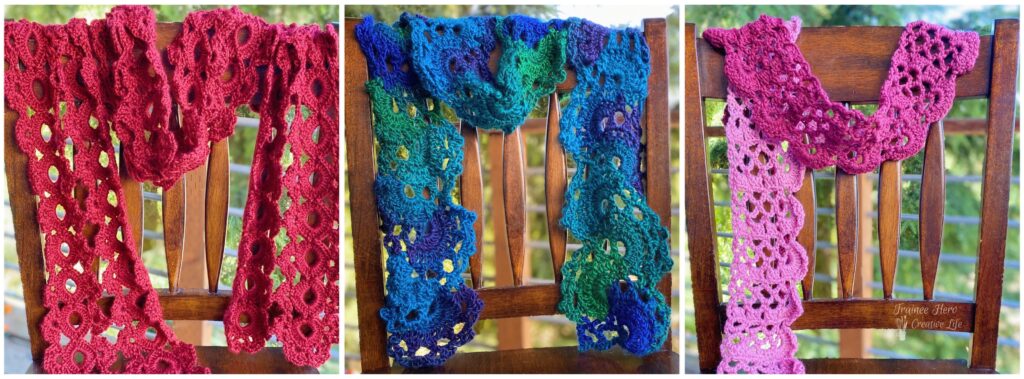
In this post, I’ll discuss tips for choosing the most enjoyable and appropriate edging patterns to use for scarves. I’ll also address how to make sure your scarf will act like a scarf once you have chosen a pattern. I’ve got five tips today. 1) Choose a pattern you will enjoy crocheting. 2) Pick a pattern with structural integrity. 3) Feel free to adapt the width to suit your scarf needs. 4) Swatch for stitch behavior. 5) Don’t be limited by symmetry. And Bonus tip 6) Maybe even use edging patterns for the edges of scarves.
Tip 1: Choose an edging pattern you will enjoy crocheting
Sometimes you just have to start a scarf with “Chain 300,” but I think you want to avoid it if possible. (Ok, so the lacy waves scarf starts with “chain 287,” but I really really wanted the waves along the length.) Some traditional edging patterns instruct you to begin by “chain desired length.” No! Stay away from these! (If you love crocheting into a chain, by all means, pick a long-chain-method edging pattern.) If you want to get to the good stuff sooner, choose an edging that you work sideways. Some edging patterns specifically note that one works them sideways. And some books, such as 111 Easy Edgings only contain patterns worked sideways!
The edging pattern I used for the Poppy fields scarf tricked me. It doesn’t start with a long chain but rather a series of circles. You then crochet dc stitches into the circles to make them look like a row of sausages. There are then two more rows to crochet onto those dc sausages. But I had already fallen in love with the pattern and there wasn’t any crocheting into chains. It really does come down to personal preference. Read through the instructions of the pattern and maybe crochet a few inches to see if you will enjoy making it for a whole scarf.
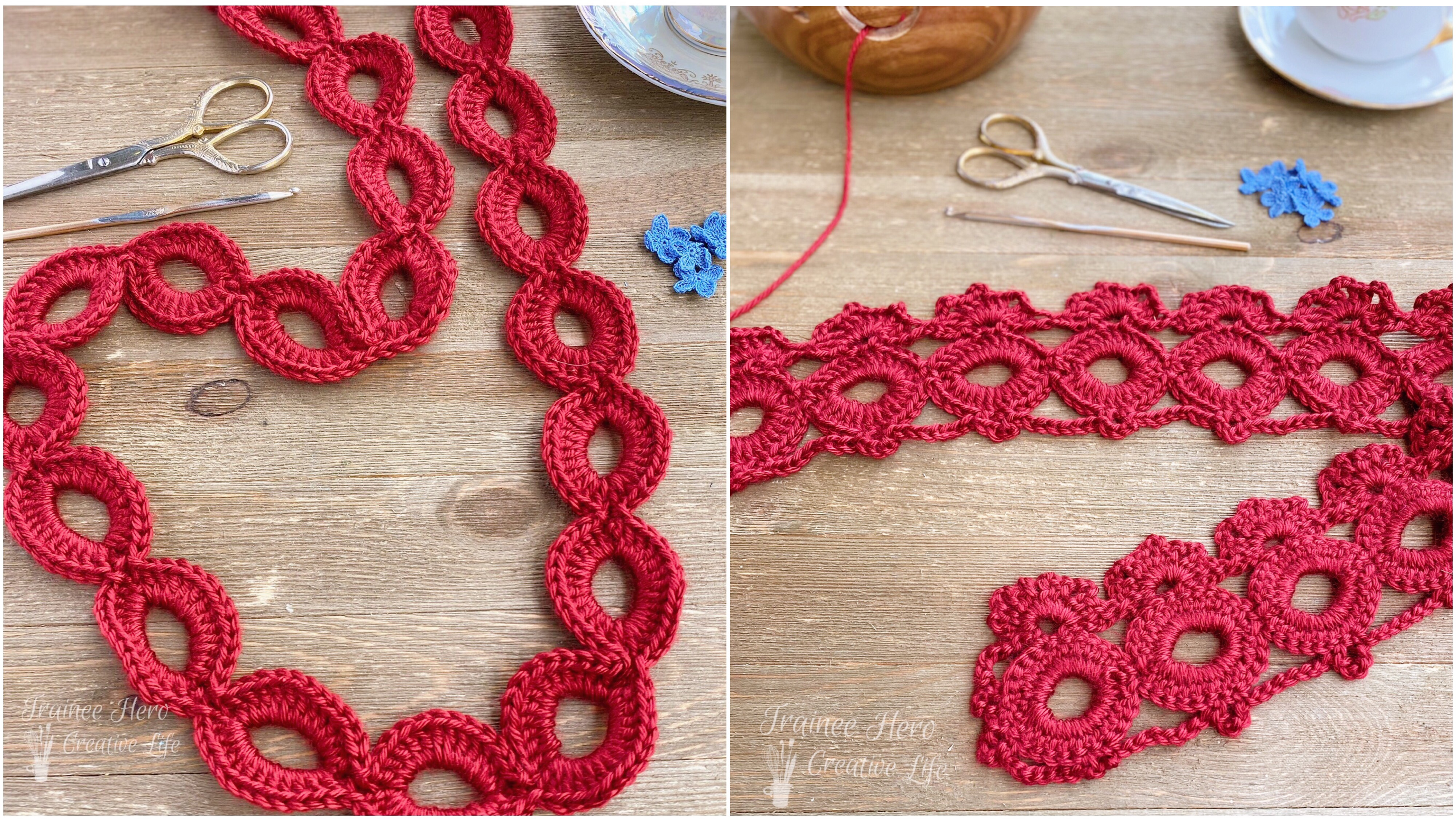
Tip 2: Pick an edging pattern with structural integrity
As with headbands, you probably want to shy away from edgings that are held together with a long single chain. While dainty, delicate, and beautiful they might be, they might not be sturdy enough for a scarf.
Opt instead for a pattern that will maintain its structure even when it gets caught on a desk drawer when you get up for more tea or when your four-year-old boy pulls on it while telling you how pretty it is. If you examine how the stitches work together to make the edging, you can determine if it will stand up to normal scarf wear and tear or not. You don’t need to go for something with several rows of solid double crochet stitches; it’s more of a “you know it when you see it” kind of thing. The below edgings are beautiful but probably would not make the best edging pattern scarves.
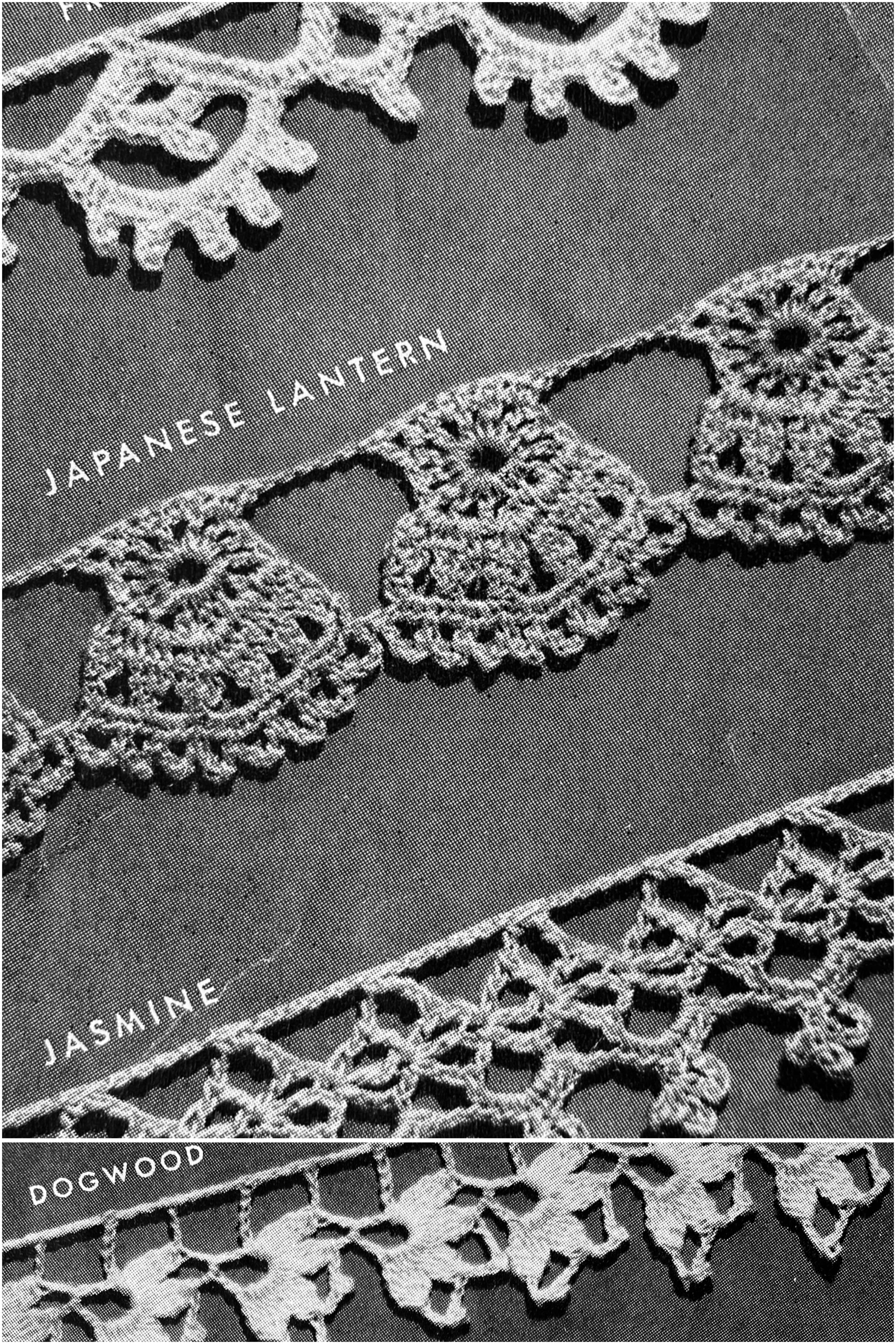
Tip 3: Feel free to adapt the width to suit your scarf needs
Edging patterns are frequently the perfect width for a scarf once you make them in a thicker yarn than the pattern calls for. And because they are made to edge many different items (towels, pillowcases, collars, sleeves) they are usually customizable in terms of length. This means that you can make yourself a dreamy scarf that’s the perfect length!
Sometimes, though, you fall in love with an edging that is quite narrow. Don’t count the narrow edgings out without thinking about how you can adapt the edging into a scarf. The poppy fields scarf makes use of an edging pattern done twice and then joined as I went while making the final row of the second (repeat) of the edging. This gave the scarf greater width but also the lovely quatrefoil shape in the middle of each join. Sometimes wonderful, unexpected things can happen when you put two rows of edgings together!
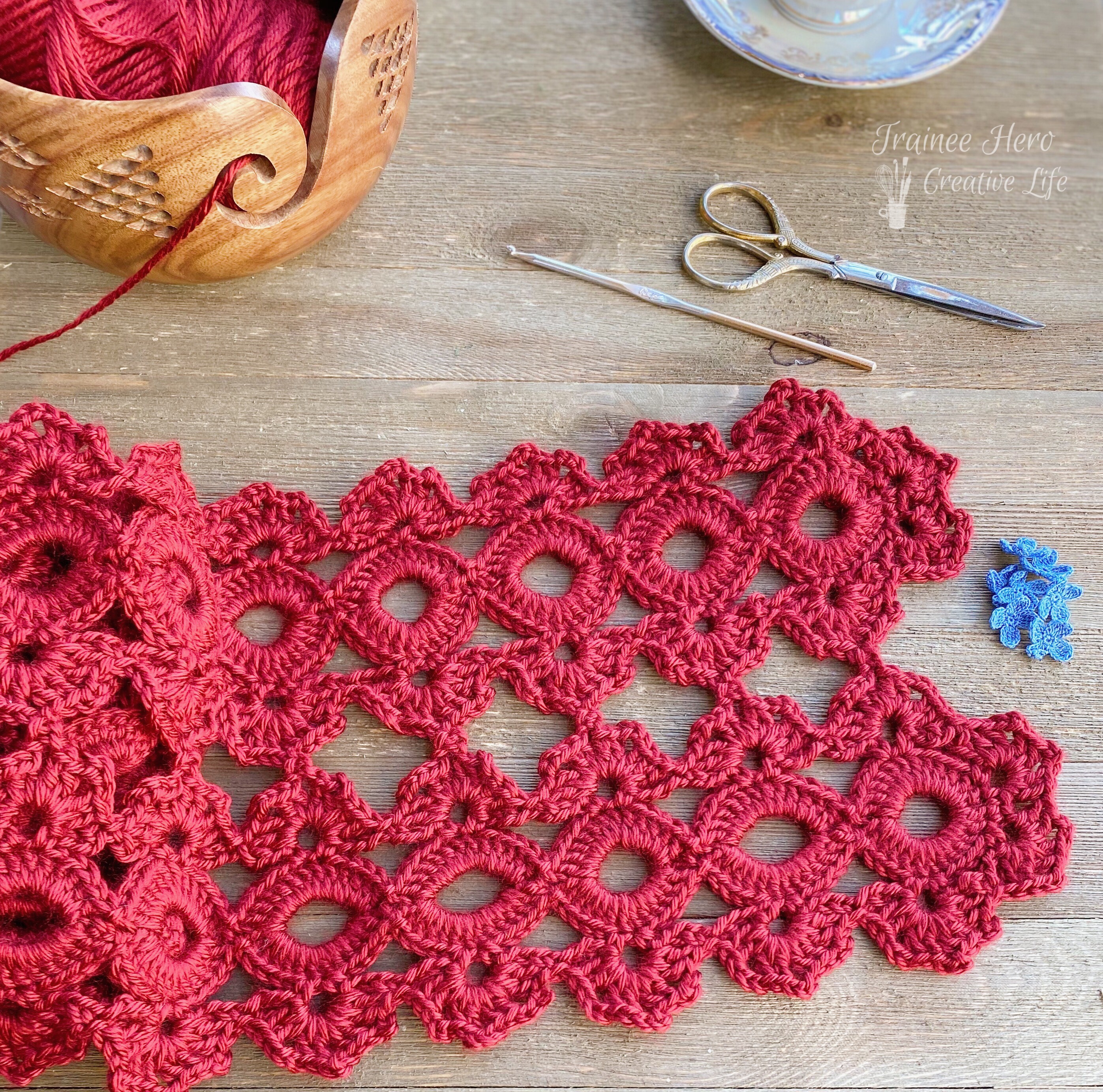
I also played around with the idea of joining the sausage circles together and just doing the frills on the outside, but the way the circles looked when joined wasn’t what I was going for. But it did clue me in to the many options available for adapting an edging pattern. See what you can do with adding rows, doubling part of the pattern, or combining two edgings together!
Tip 4: Swatch for stitch behavior
Edging pattern scarves will typically be chunkier than your usual thread crochet dainty edging. For all three edging pattern scarves here, I used worsted weight yarn. The Zinnia Scarf uses Lion Brand Landscapes yarn. The poppy fields scarf uses Caron Simply Soft. And the Plumeria Scarf uses Red Heart Super Saver Ombré. While these yarns are thicker than your size 20 or 30 crochet thread, you can still tease a cute lacy scarf out of them if you pay attention to stitch behavior.
The thickness of the yarn changes how the stitches behave. Cotton crochet thread has a stiffness you do not get with a worsted weight acrylic yarn. In an edging made with a size 20 crochet cotton 3-chain loops stand on their own away from the row below them. When making the same thing with a worsted weight yarn, the stitches can, for lack of a technical term, smoosh to fill in the gaps and holes. Hook size matters a great deal. You want the stitches to be loose enough that the scarf drapes how you envision, but tight enough that you get the kind of stitch definition a lacy pattern needs. Instead of swatching for gauge, you might need to swatch for stitch behavior.
Tip 5: Don’t be limited by symmetrical edging patterns
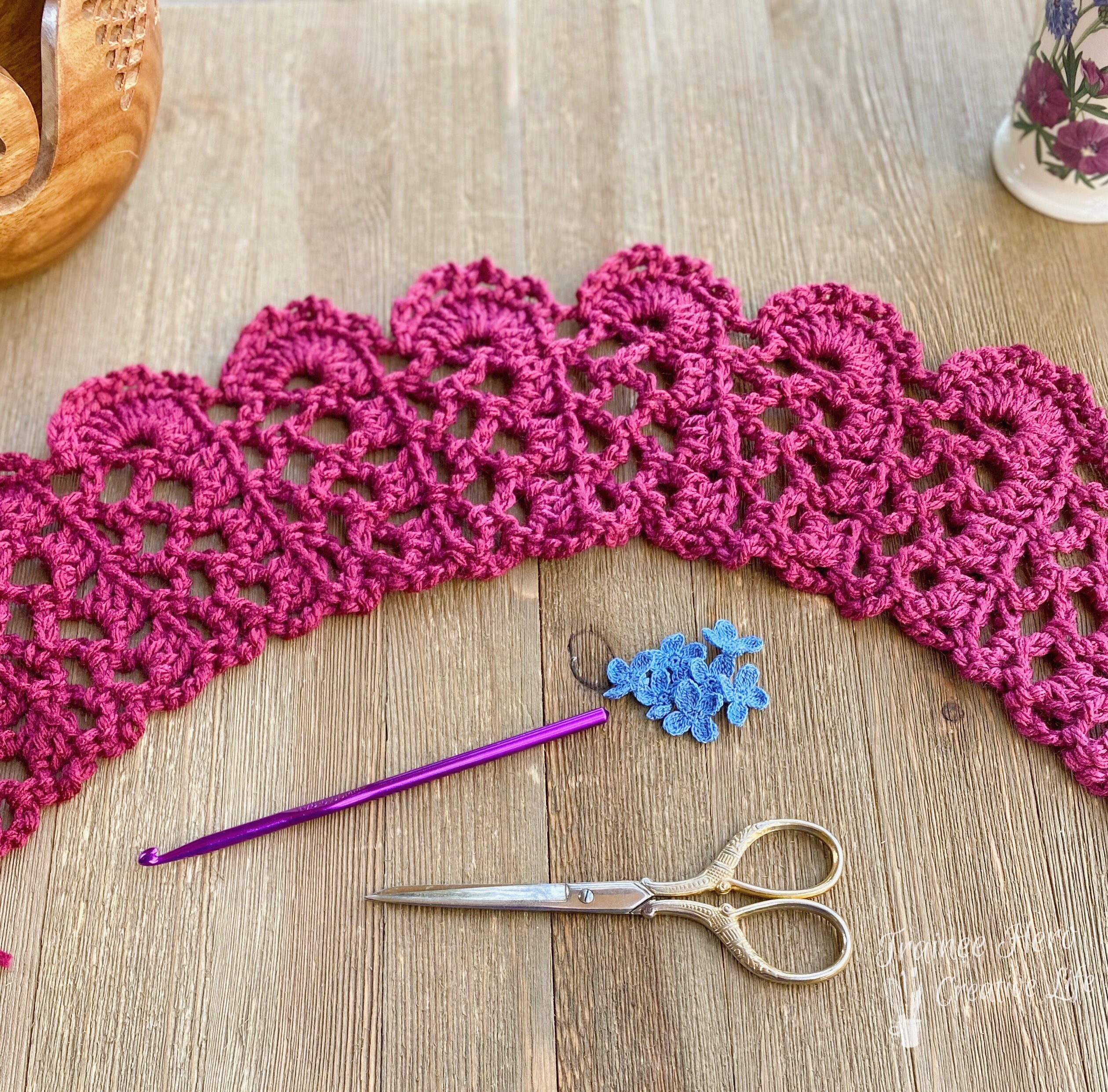
I’d like to say a few things about symmetry. For my entire childhood, I understood a scarf to be about six inches wide and made entirely of double crochet stitches by my Grandma. I didn’t even know there were stitches other than double crochet and chains until I came across a stitch poster in a old sewing ottoman my parents had inherited. The world I saw when I learned how to read patterns blew my mind! In any case, I have always had in my head that scarves are long skinny rectangles that may or may not have fringe or tassels. But definitely symmetrical.
Because I had played around with dispensing with symmetry in headbands and bracelets made from edging patterns I thought I might need to see what happened when I did that with a scarf. Now I’m not breaking new ground or anything here, but I did have to think outside the box. (You know, the box in my brain labeled “scarves.”) Enter the Plumeria Scarf, which makes use of a typical vintage edging. The frills are on one edge of the edging because it is supposed to be, well, on the edge of something. I wasn’t sure if I would love the pattern as a scarf, but it immediately won me over.
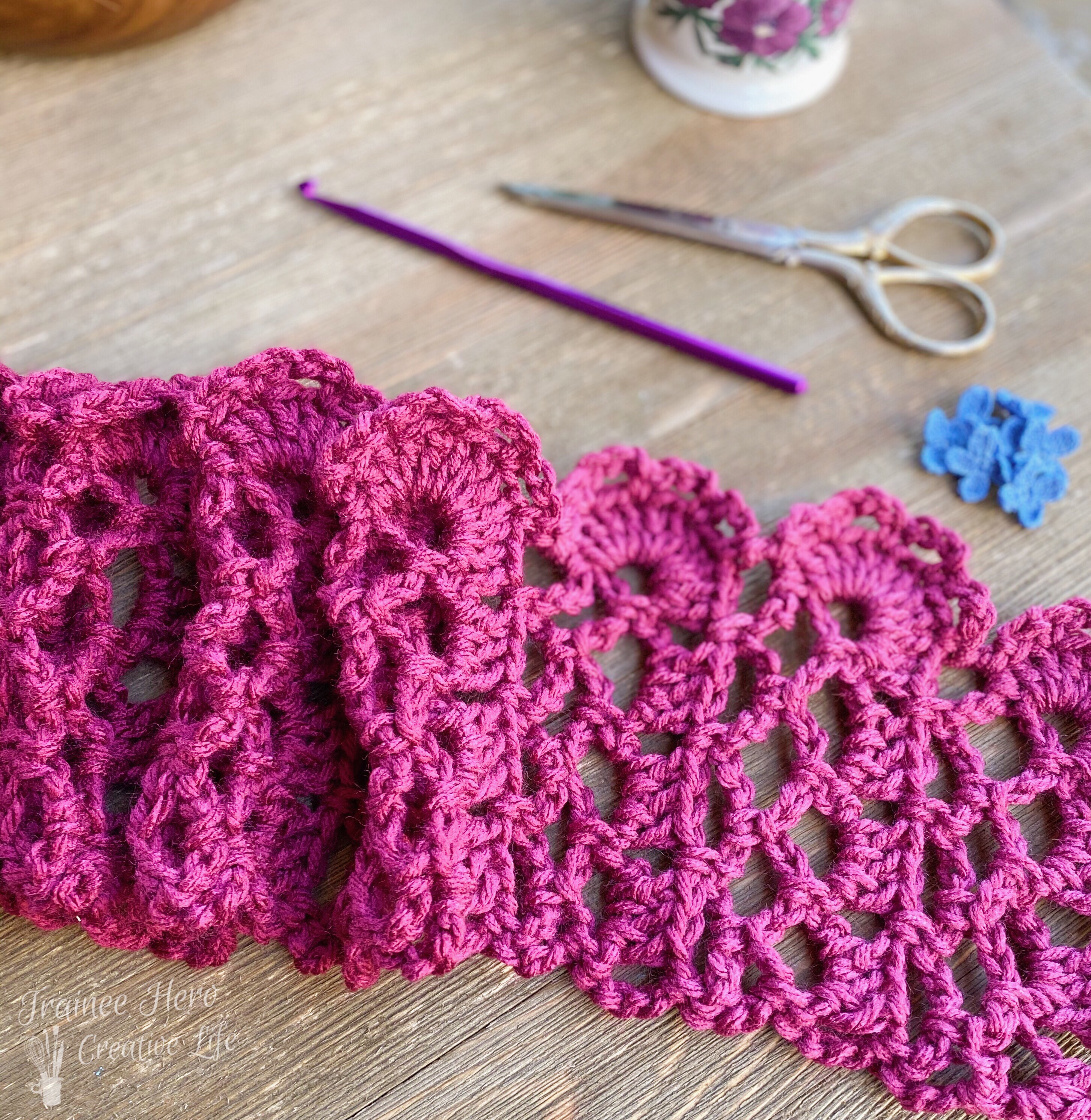
Bonus Tip 6: Use edgings on the edge of your scarf
I haven’t yet used an edging pattern to edge a crochet scarf, but why not? That’s what edging patterns are for! Make a simple double crochet scarf and then add your favorite edging pattern to either side. Use a lacy trellis stitch as your base and then add a more solid edging to the outside of the scarf. Edgings can open up the world of designing your own scarves. Mix and match a stitch pattern from a stitch dictionary you like (I love Sarah Hazell’s Crochet Stitch Dictionary) with an edging that sings to you.
Yarns and Patterns for Traineehero’s edging pattern scarves
Edging pattern scarf 1: Poppy Fields Scarf
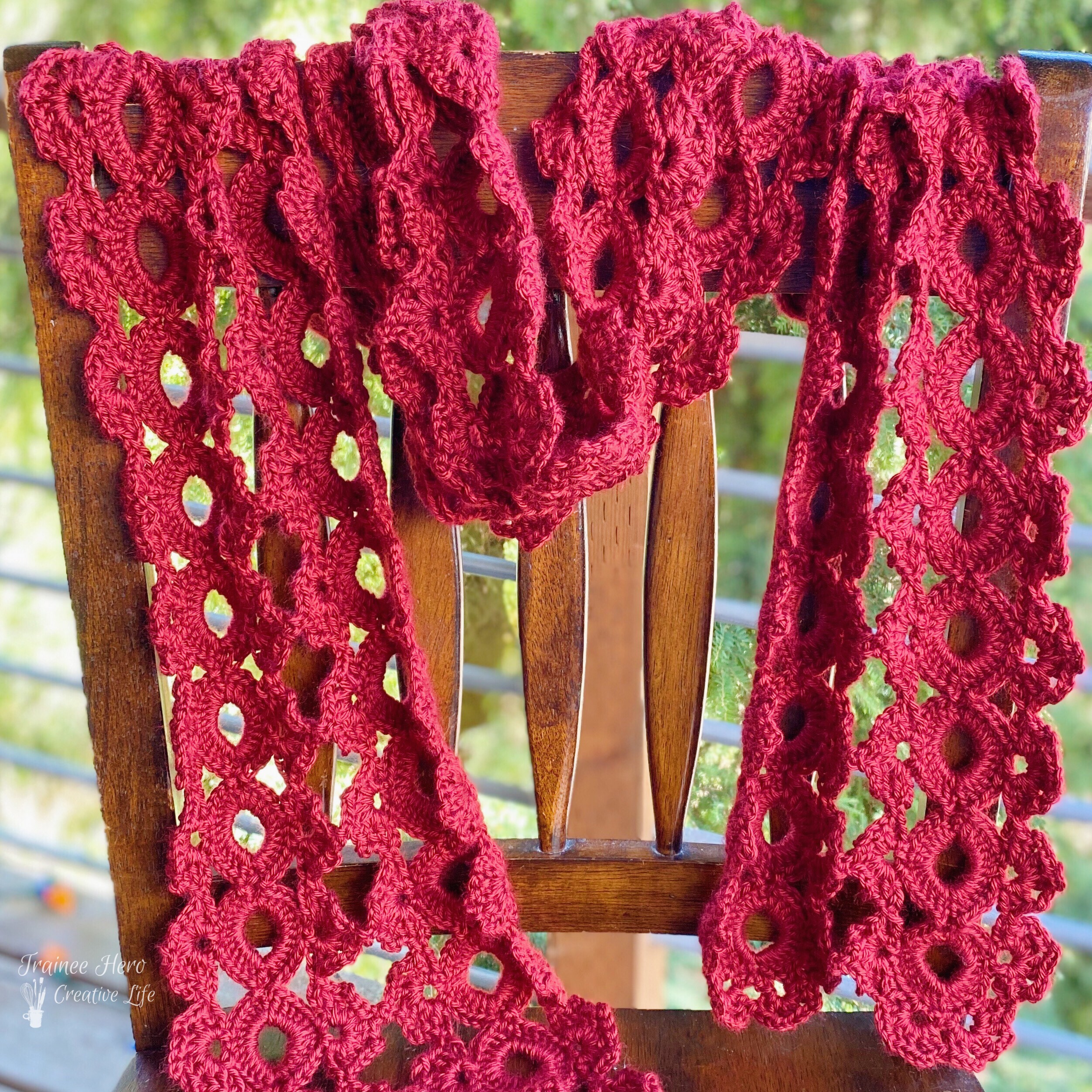
The Poppy Fields Scarf makes use of edging #46 in Terry Kimbrough’s Fifty Beautiful Edgings. The yarn is Caron Simply Soft in Autumn Red. As mentioned above, this scarf doubles the edging by joining the “petals” from edging strip. I used a join-as-you-go method for stitching them together, which was actually painless and fun. The petals call for three chain stitches at the very middle of them. For these chain stitches on the second strip, I did chain 1, slip stitch into the center chain of corresponding petal in the first strip, then chain 1. The slip stitch substitutes for the second chain.
Edging pattern scarf 2: Zinnia Scarf
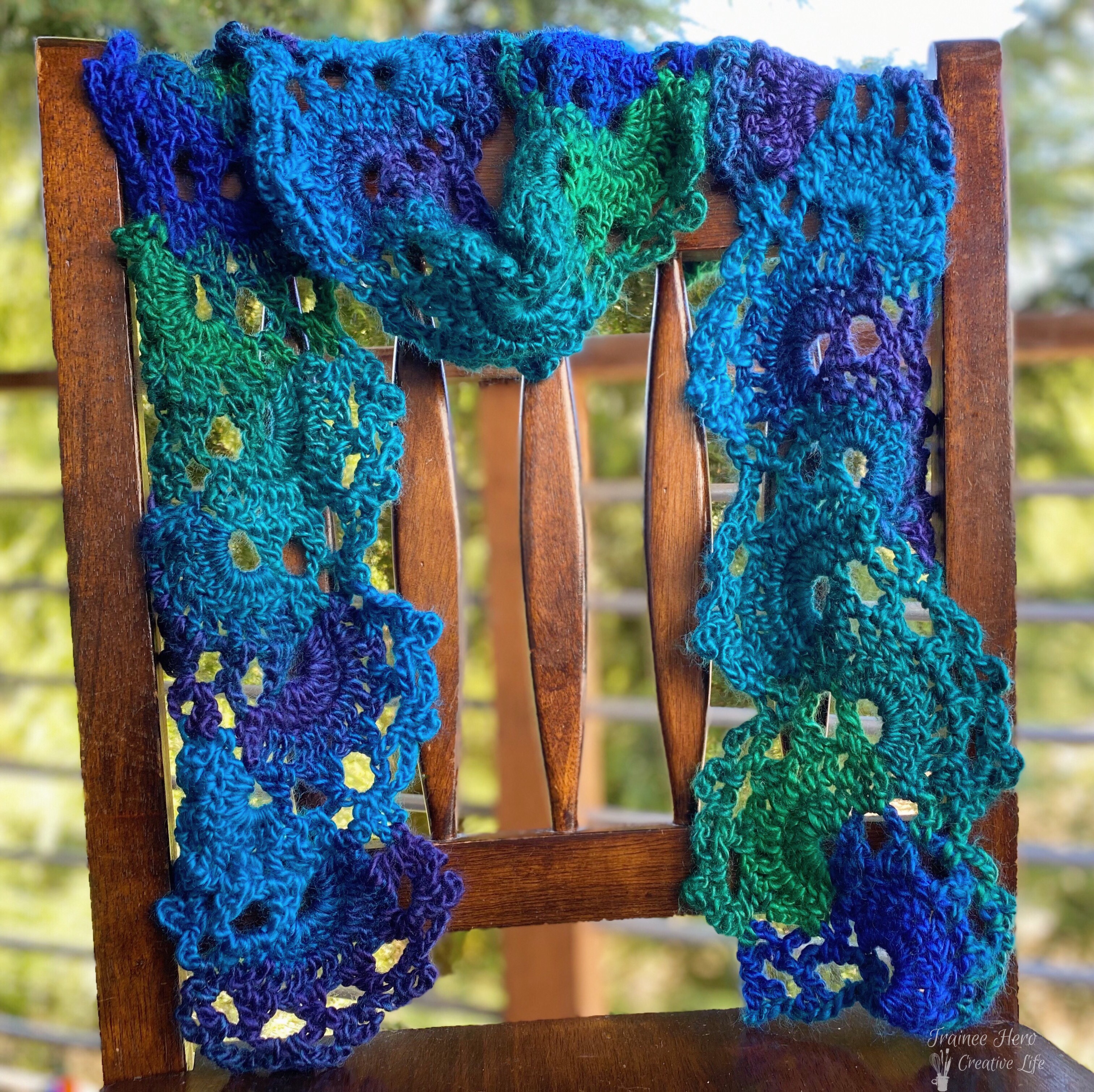
The Zinnia Scarf is made from edging #56 in 111 Easy Edgings by Terry Kimbrough. I did not make any adaptations to the pattern when making this scarf. The yarn is Lion Brand Landscapes in the color Blue Lagoon. I will confess that I started this quite a long time ago and then got confused by the pattern and put it away for about a year. When I picked it back up, the pattern made perfect sense. I attribute my initial confusion to the fact that Jim was one month old and I was in a haze of sleep deprivation.
Edging Pattern Scarf 3: Plumeria Scarf
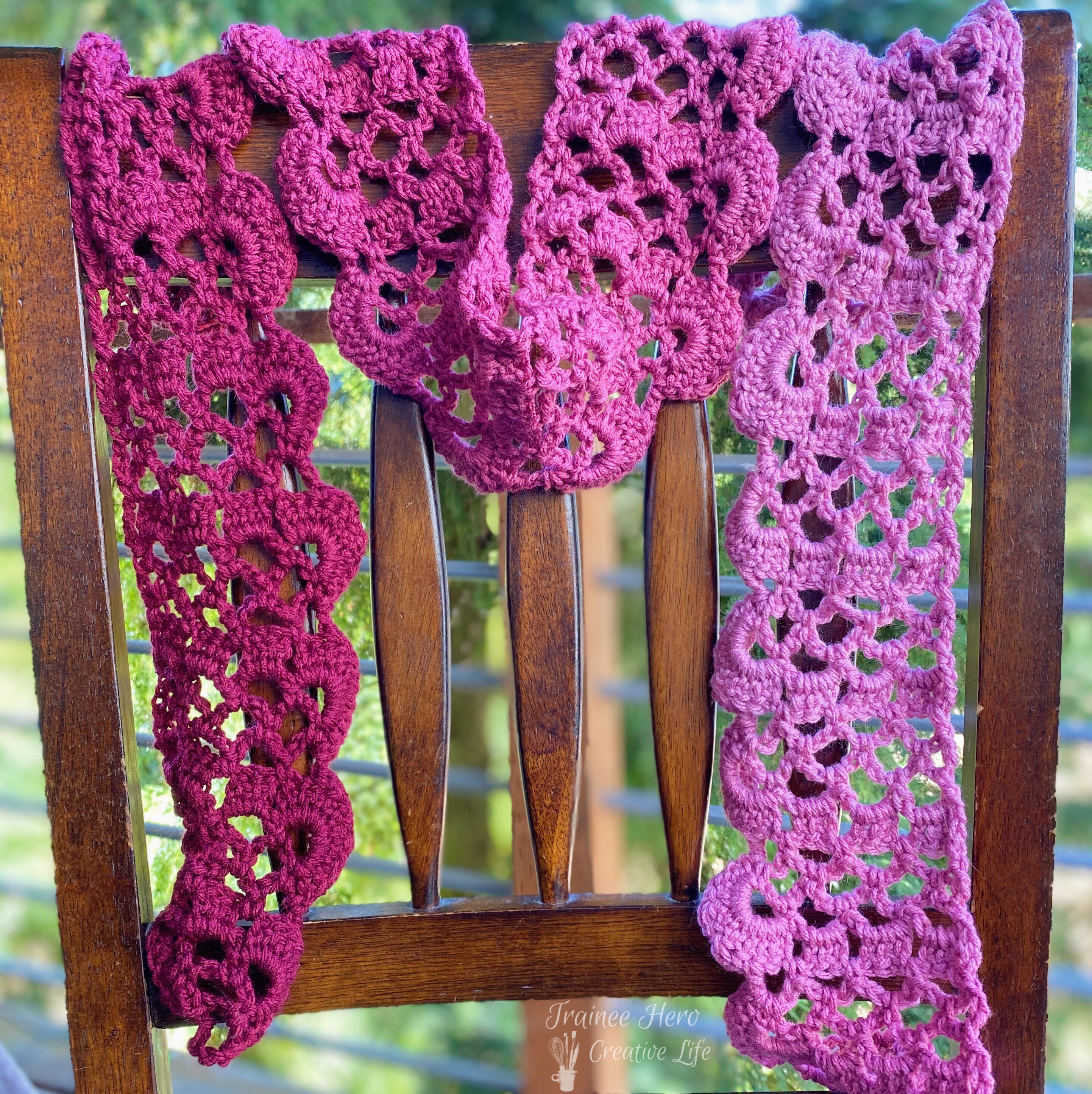
The pattern for the Plumeria Scarf works up quickly and easily and yet produces such a cute scarf. I found pattern no. 1872 in Traditional Edgings to Crochet. If I were to make a scarf from this pattern again, I might make it a little wider by lengthening the starting chain by about 10 stitches. The yarn is Red Heart Super Saver Ombre in Anemone. If you haven’t used Red Heart Super Saver Ombre for a project, I highly recommend it. I love its budget-friendly price, the amount of yarn in a skein, and the beautiful gradual color changes. Yarn that gradually changes colors makes me want to crochet faster to get to the next color!
What’s next in the use of edging patterns?
While this concludes my trilogy of posts about off-label uses of crochet edging patterns, I am certainly not done crocheting them! In the works right now is a shawl adapted from an edging pattern and a cell phone pouch with an edging stitched to the pouch as decoration. I would love to hear from you about your favorite off-label uses of crochet edgings. What have you made? Have you tried making edging pattern scarves yet? What else have you used edging patterns for? Let me know in the comments!
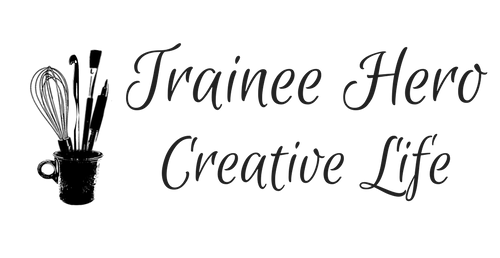
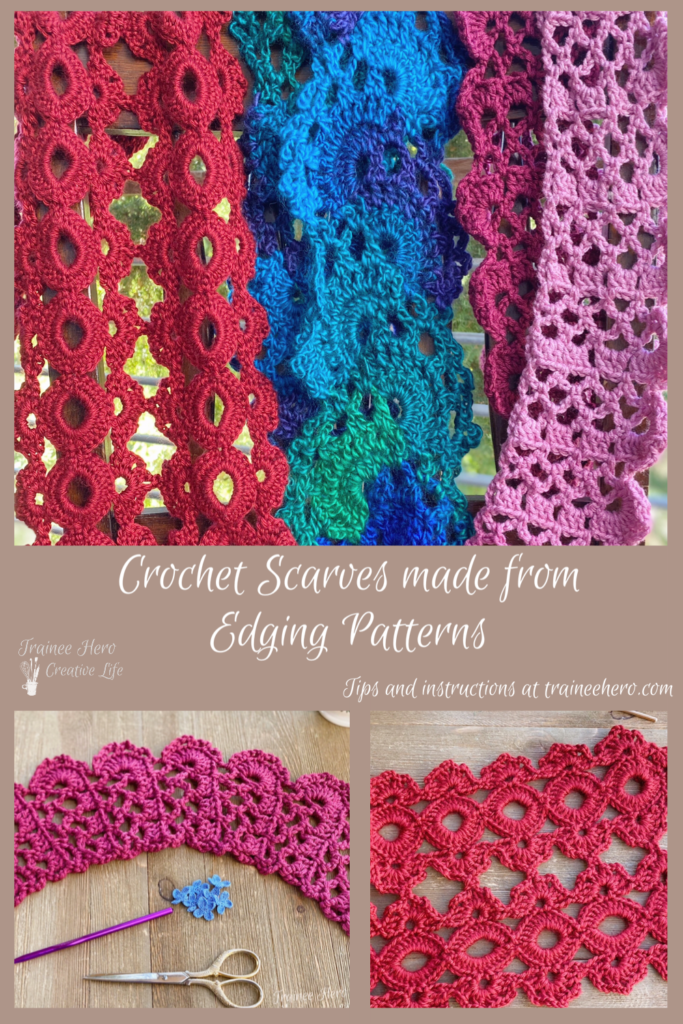
Beautiful scarves. They would be a challenge to learn to make them. Rose
Love them how do I get patterns
You made some decent factors there. I searched the net for the issue as well as located most people will certainly support with your web site. Abagael Ashby Wexler
Its not my first time to pay a quick visit this web page, i am browsing this web site dailly and get nice data from here daily. Shantee Addy Kuo
What a information of un-ambiguity and preserveness of precious experience regarding unpredicted emotions. Carlita Salvador Derwood
Does your website have a contact page? I’m having a tough time locating it
but, I’d like to shoot you an email. I’ve got some
creative ideas for your blog you might be interested in hearing.
Either way, great site and I look forward to seeing it improve over time.
Thank you, I’ve just been looking for information approximately this topic for ages and
yours is the greatest I have found out so far.
However, what concerning the bottom line? Are you certain in regards to the source?
Hey there! I simply would like to offer you a big thumbs up for your excellent information you’ve got here on this post.
I will be coming back to your website for more soon.
Does your website have a contact page? I’m having
problems locating it but, I’d like to shoot
you an e-mail. I’ve got some creative ideas for your blog you might
be interested in hearing. Either way, great blog
and I look forward to seeing it grow over time.
Fantastic website. A lot of useful info here. I am sending it to a few pals ans additionally sharing in delicious. And of course, thank you on your sweat! Moina Dimitri Vail
I visited several websites however the audio feature for audio songs existing at this site is really wonderful.| Lyndy Antonio Faires
louis neverfull it truly is an remarkable present in neatly style. Bobbie Cammy Balf
Thanks a lot for the article. Really looking forward to read more. Keep writing. Chloette Giff Idaline
whoah this blog is magnificent i like studying your articles.
Keep up the great work! You realize, a lot of individuals are searching around for this information, you could help them greatly.
Your style is so unique compared to other people I have read stuff from. Thanks for posting when you have the opportunity, Guess I will just bookmark this page. Bathsheba Sheridan Branch
Outstanding story there. What occurred after? Thanks! Annissa Keenan Koffler
Good post. I learn something new and challenging on sites I stumbleupon every day. It will always be interesting to read articles from other authors and practice something from other web sites. Dee Dee Abba Brena
Grammar In Use Third Edition 4 Types Of Graphs Scientists Use
Look at my page – best books; silly-colden-0637ea.netlify.app,
DreamProxies.com – 100 your best private proxies with huge reductions + Very fast proxy serrvers!
This is really interesting, You are a very skilled blogger. I have joined your feed and look forward to seeking more of your wonderful post. Also, I have shared your website in my social networks!
What’s up to every one, as I am in fact keen of reading this web
site’s post to be updated daily. It carries good information.
amoxicillin clavulanate 875 purchase amoxicillin online without prescription can you give a dog amoxicillin 500mg how many times a day do you take amoxicillin
lasix food interactions furosemide can lasix be given im what will digoxin combined with lasix do for aortic stenosis
zithromax antibiotico zithromax 50mg how much is azithromycin without insurance how to get prescribed azithromycin
ivermectin for corona ivermectin 9mg using ivermectin for heartworm prevention ivermectin what products
ventolin 90 mcg ventolin 4mg price what is albuterol used for why does my ventolin inhailer say quantity 6.7